Salmon, Fluoridation & the Russian River Biological Opinion
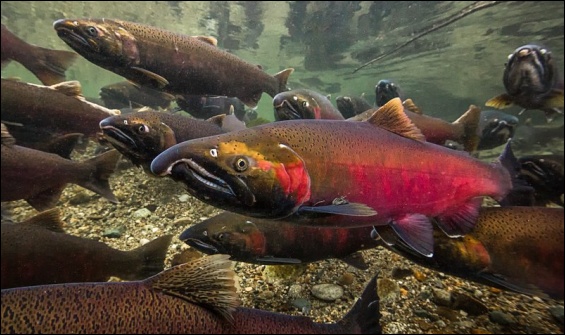
“For all the troubles they face, salmon still inhabit the soul of the Pacific Northwest. Even though humans play awkward midwives to many salmon — barging them around dams to reach the ocean, or slicing them open to incubate their eggs in plastic cages — the fish leave their imprint on the place where we live. From their birthplaces in tiny creeks, they migrate thousands of miles to feed in the northern Pacific, returning years later to the same streams to mate and die. After they do, they offer themselves up to raven, raccoon, and others; diminished though their numbers may be, they connect ocean denizens and land dwellers in a bond that has been recognized since the days of the first peoples. That dream of living with the salmon and healing the relations between our species has motivated hundreds of initiatives by citizen groups and entrepreneurs throughout the fish’s range.” From Toward a New Salmon Economy by Seth Zuckerman
THE RUSSIAN RIVER BIOLOGICAL OPINION
The Russian River Biological Opinion is a federally mandated 15-year blueprint to help save endangered fish and ensure our water supply. The Sonoma County Water Agency (Water Agency) has created the Russian River Instream Flow and Restoration Project (RRIFR) Project to implement the mandates of the Russian River Biological Opinion.
SALMON AS AN ECONOMIC ASSET
According to an article in the October 2014 Smithsonian Magazine, salmon contributes at least $1 billion to the Washington State economy annually (Priscilla Long, “What Can Humans Do to Save the Pacific Northwest’s Iconic Salmon?”). Salmon could become equally important in California.
PROPOSED WATER FLUORIDATION THREATENS SALMON SURVIVAL
Health Department proposes Sonoma County water fluoridation: Several years ago the Sonoma County Department of Heath Services (DHS) proposed that the Board of Supervisors vote that a policy of water fluoridation be implemented through the Sonoma County Water Agency (SCWA).

SCWA has 156 active connections, all of which would receive fluoridated water if the Board of Supervisors vote to approve. Agency customers include the Town of Windsor, The City of Santa Rosa, The City of Rohnert Park, The City of Cotati, the City of Petaluma, the City of Sonoma, Valley of the Moon Water District, and the North Marin Water District (NMWD), which serves the City of Novato. With SCWA, those water cities and water districts are the signers of the Restructured Agreement for Water Supply, which required unanimous agreement to implement. Any changes to the Restructured Agreement also require unanimous agreement. NOTE: In 2013 the Cotati City Council voted to rejectwater fluoridation, and wrote to inform the Sonoma County Board of Supervisors . The Sonoma City Council followed suit, rejecting water fluoridation in February 2015. If SCWA’s water were fluoridated, would the decision of those cities be honored? More to the point, could water provided by SCWA be fluoridated if those cities do not sign on?
Because over 95 percent of fluoridated water returns to the environment as recycled water or wastewater, and since none of Sonoma County’s recycled or wastewater treatment facilities can remove fluoride, the Board of Supervisors requested that DHS commission a fluoridation environmental assessment, “Assessment of Potential Impacts to Federally Listed Salmonids from Community Water Fluoridation in Sonoma County, DRAFT.“
Of the DHS Draft Assessment’s several flaws, its narrow field of inquiry might be the most troubling. See Stephen Fuller Rowell’s critique, “Fluoride vs. Fish: Sonoma County Health Dept’s EIR Report, Fluoridation.”
Based on available evidence, the Sonoma Group of the Sierra Club, and the Sonoma County Water Coalition have expressed concern that the proposed Sonoma County fluoridation project poses a threat to Sonoma County salmon spawning, and to the food chain on which young salmon depend.
As noted in the Biological Opinion Q & A (below), “it’s currently estimated that the habitat enhancement, monitoring, and studies required of the Water Agency and the Corps will cost approximately $150 million to $165 million over 15 years.” These costs are substantial. Monitizing all the potential negative externalities of County Health Services’ proposed fluoridation project would yield a much higher figure .
“A critique of recent economic evaluations of community water fluoridation” (2014), by Lee Ko, and Kathleen Thiessen of the SENES Oak Ridge, Inc. Center for Risk Analysis, addresses water fluoridation costs over and above degradation of salmon habitat (See below).
Regarding the proposed fluoridation, Dick Butler, the architect of the Biological Opinion for the Russian River said in a recent letter to the Press Democrat: “If the County is serious about restoring our salmon and steelhead, the Supervisors should adopt a precautionary approach and not add another toxin to the mix.”
The video “Fluoridation and the Environment” by Howard J. Patterson, offers a concise introduction to the risks that low concentrations of fluoride pose to salmonid survival. [The video is also clickable in our sidebar.]
PDFs available on request: 1. Damkaer & Dey’s “Evidence for Fluoride Effects on Salmon Passage at John Day Dam, Columbia River, 1982-1986”, 2. “Sierra Club comments on the Draft Aquatic Assessment presented to the Fluoridation Advisory Committee on October 20, 2014”, 3. Sonoma County Water Coalition’s “Comments on the Draft Assessment of Potential Impacts to Federally Listed Salmonids from Community Water Fluoridation in Sonoma County”, and 4. Ko & Thiessen’s “A critique of recent economic evaluations of
community water fluoridation.”
FISHERIES MONITORING
Regardless of which portion of the Russian River young salmon and steelhead originate, all must travel downstream through the mainstem Russian River and estuary as they make their way to the ocean. The Water Agency monitors the effects that changes in river management related to the Russian River Biological Opinion have on salmon and steelhead populations over time by operating facilities designed to detect the movement of these fish out of tributaries and into the lower river.
ENVIRONMENTAL OVERSIGHT
Environmental Resources staff provides environmental compliance services, including CEQA and NEPA environmental impact assessment, and consultation on County General Plan land use consistency, and mitigation monitoring.
The Russian River Biological Opinion is a federally mandated 15-year blueprint to help save endangered fish and ensure our water supply. The Sonoma County Water Agency (Water Agency) has created the Russian River Instream Flow and Restoration (RRIFR) Project to implement the mandates of the Russian River Biological Opinion.
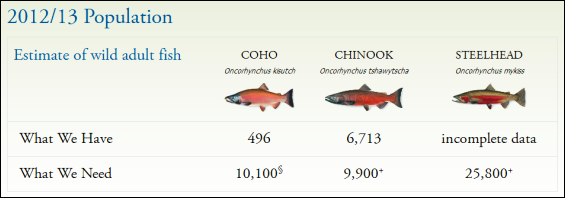
Read more on Russian River watershed salmon populations at California Salmon Snapshots: Russian River, The Nature Conservancy.
THE BIOLOGICAL OPINION: FREQUENTLY ASKED QUESTIONS
What is a “biological opinion”?
A biological opinion is a determination made by a federal agency—in this case the National Marine Fisheries Service (NMFS)—to help restore and protect threatened or endangered species. Biological opinions are prepared when federal government agencies consult with other federal agencies in a process spelled out in Section 7 of the Endangered Species Act.
In essence, biological opinions summarize the studies done during the Section 7 consultation process, analyze the impact of a specific project, and determine whether the project is likely to harm the survival and the recovery of the species. If the biological opinion finds that the species are likely to be harmed by the project, it includes “reasonable and prudent alternatives” that must be implemented. In this case the project is the ongoing water supply and flood control activities of the U.S. Army Corps of Engineers (Corps) on behalf of the Sonoma County Water Agency (Water Agency) and the Mendocino County Russian River Flood Control and Water Conservation Improvement District in the Russian River watershed.
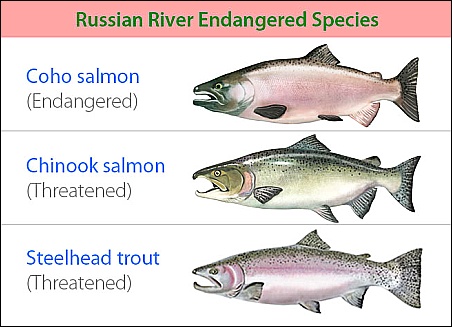
What problem is the Russian River biological opinion trying to solve?
The Russian River and its major tributaries are home to three species of fish that are threatened or endangered: steelhead, coho salmon and Chinook salmon. There are many reasons for the decline of these species, including historic overfishing, gravel mining,
development near the river and its tributaries, increased sedimentation from logging and historic agricultural practices, and changing climate and ocean conditions. The reasons also include flood control and water supply projects in the river and in Dry Creek. The flood control and water supply projects are the sole focus of the biological opinion.
Essentially, the biological opinion addresses the following questions:
1. Do the flood control projects operated by the Corps and the water supply and flood control projects operated by the Water Agency threaten to jeopardize the continued existence of steelhead, coho, and Chinook?
2. If the answer to question #1 is yes, how can these projects or operations be changed to enable the survival and the recovery of the species?
What does this biological opinion find?
After more than 10 years of studies, NMFS found that some aspects of flood control and water supply operations threaten to jeopardize steelhead and coho but not Chinook. This jeopardy opinion means that the Water Agency and the Corps must change operations.
AREAS OF PARTICULAR CONCERN:
1. High summertime flows in the Russian River and Dry Creek
Contrary to what biologists believed in 1986, when the State Water Resources Control Board set minimum summertime Russian River flows in a ruling referred to as Decision 1610, biologists have concluded that fast-moving water in the river and Dry Creek makes it difficult for juvenile steelhead and coho to grow and thrive.
The high velocity of water in Dry Creek in the summer Fourteen-mile-long Dry Creek is the means by which water from Lake Sonoma gets to the Russian River. As described above, the fast-moving water makes it difficult for young fish to thrive.
The biological opinion requires that, over a 15-year period, there be habitat enhancement and changes in the configuration of the channel to create slow-moving pools and fish refuge along six miles of the creek.
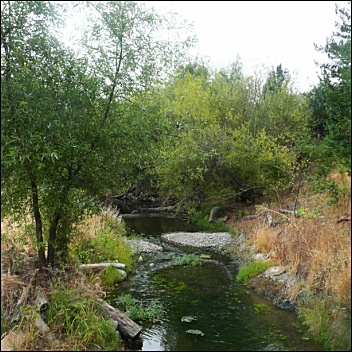
2. The current practice of “breaching” the sandbar at the estuary
Federal biologists believe that breaching negatively affects the estuary (the mouth of the river) by allowing more saltwater than is natural to flow into it and by keeping the amount of freshwater artificially low. The biological opinion requires the Water Agency to adopt “adaptive management” practices in the estuary, with the goal of installing an outlet channel in the barrier beach in the summer months to create a freshwater lagoon in which young steelhead can grow.
What is a reasonable and prudent alternative?
When a biological opinion finds that current or proposed activities could threaten the continued existence of a threatened or endangered species, it includes steps for public agencies to take to avoid further problems.
REASONABLE & PRUDENT ALTERNATIVES
In the case of the Russian River biological opinion, reasonable and prudent alternatives include the following:
• Reducing summertime flows in the river and Dry Creek
• Enhancing six miles of habitat in Dry Creek
• Creating a freshwater lagoon in the estuary during the summer months
• Carefully monitoring both habitat and fish in Dry Creek, the estuary, and the river
• Eliminating impediments to fish spawning or improving habitat in several streams
• Improving the existing coho broodstock program
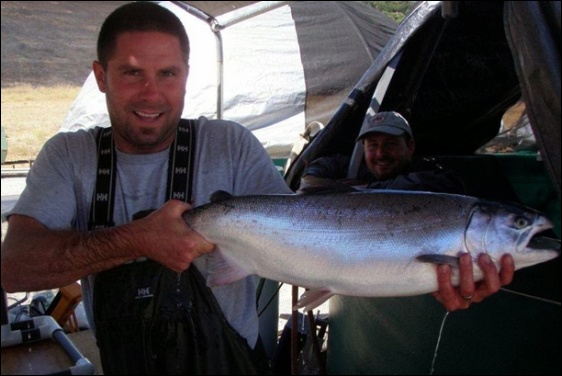
Who is involved?
The National Marine Fisheries Service, the Sonoma County Water Agency, the U.S. Army Corps of Engineers, the Mendocino County Russian River Flood Control and Water Conservation Improvement District, and the California Department of Fish and Game are the agencies involved, with the Water Agency and the Corps responsible for implementing the reasonable and prudent alternatives.
How long will this biological opinion be in effect?
The Russian River biological opinion is a 15-year plan that began in September, 2008.
What happens if the Water Agency fails to implement the biological opinion?
The Water Agency is committed to carrying out the biological opinion, but many of the projects envisioned in later years could change as data becomes available from projects implemented earlier and from the extensive studies and monitoring involved. Think of the biological opinion as a blueprint that can be adjusted by agreement as the situation evolves and new information becomes available.
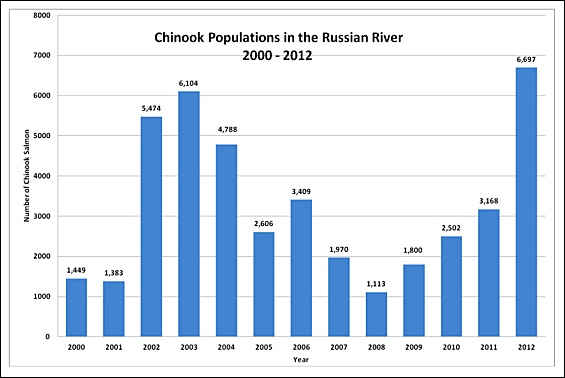
How much will it cost?
Only a handful of items in the biological opinion include dollar amounts. The Water Agency and the Corps calculated the costs of the vast array of projects and developed a financial plan and a budget. While subject to change, it’s currently estimated that the habitat enhancement, monitoring, and studies required of the Water Agency and the Corps will cost approximately $150 million to $165 million over 15 years.
Who is paying for it?
Funding comes from a variety of sources, including ratepayers, state and federal grants and existing tax revenues that can be designated for this purpose.
Who is overseeing its implementation?
The biological opinion requires that the Water Agency conduct extensive monitoring and reporting. The data is provided to NMFS and the California Department of Fish and Game, which monitors the work.
There are several ways the public can get involved:
• Environmental documents have been or will be prepared for the different actions required to implement the biological opinion. The environmental review process includes many opportunities for people to comment.
• Staff from the Water Agency and NMFS regularly conduct informational presentations to community and neighborhood groups.
More information is available.
What is an estuary? And why is it important to steelhead, coho, and Chinook?
An estuary is where a river meets the sea. The convergence of freshwater from the river and saltwater from the sea creates a dynamic environment that supports a broad diversity of fish, wildlife and invertebrate and plant species. Estuaries play an important role in the life history of steelhead, coho and Chinook. Salmon use estuaries to adapt to saline conditions prior to entering the ocean and to adapt to freshwater before migrating upstream to the spawning grounds. Some species, particularly steelhead, spend extended periods of time in estuaries.
I thought fish need lots of water, so why does the biological opinion require less water in the Russian River?
Biologists have concluded that current flow releases into the river are much higher during the summer than under natural conditions and are too high for young steelhead and coho. Reducing summer flows in the Russian River would provide better habitat by reducing velocity, would eliminate the need to artificially breach the sandbar at the estuary and may improve summer habitat in the estuary by allowing the formation of a freshwater lagoon. Reducing summer flows in the upper Russian River would also retain a greater amount of the cold-water pool in Lake Mendocino, which would be available to be released in the late summer and the early fall, benefiting Chinook returning to the river to spawn.

What is the process for changing the summertime flows in the Russian River?
Summertime flows are controlled by Decision 1610, the ruling that requires minimum flow levels at specified areas of the Russian River and Dry Creek. The minimum flow levels vary, depending on whether the year is “normal,” “dry,” or “critical.” (Decision 1610 requires that the Water Agency release water from Lake Mendocino and Lake Sonoma to maintain these flows regardless of the amount of water that others take from the river and the creek.)
The biological opinion requires that summertime flows be permanently reduced to replicate river conditions in dry years (although the biological opinion does acknowledge the complexity of operating the system and allows flows to vary).
Since the Biological Opinion was released, the Water Agency has submitted a petition to the State Water Resources Control Board (State Board) asking for changes to Decision 1610 and is preparing an Environmental Impact Report (EIR) required by the California Environmental Quality Act. This petition triggers a process, which could take several years.
The State Board will weigh the information provided in the EIR with other factors when
making the ultimate decision on summertime flows. In addition, because the biological opinion requires lower flows beginning in 2010, the Water Agency annually petitions the State Board for interim changes to Decision 1610.
Because Dry Creek is the conduit to get Lake Sonoma water to the Russian River, if there is less water in the creek, won’t that mean less water for people?
The reasonable and prudent alternatives provide for habitat enhancement in Dry Creek. The goal is to naturalize the creek in a way that allows water to continue to flow to meet the current demands of people while creating slow-moving pools and shady areas for young steelhead and coho to grow.
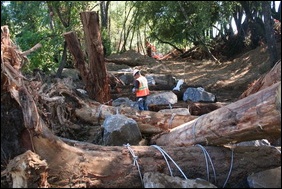
If less water is needed in the river, would the diversion of Eel River water end?
Pacific Gas & Electric’s diversion of Eel River water through the Potter Valley Project is regulated by the Federal Energy Regulatory Commission. These diversions from the Eel River are not controlled by the Water Agency and will not change as a result of the biological opinion.
Does the biological opinion require a pipeline to be built from Lake Sonoma to the Russian River?
No. The biological opinion does not require the construction of a pipeline. It does require a pipeline feasibility study, which was finalized in 2011. If habitat enhancement projects in Dry Creek are determined to be unsuccessful, in year 10 (2018), the biological opinion requires a change in approach, which could result in additional pipeline studies.
How will less water in the river affect summertime recreation?
Canoeists, kayakers, swimmers and people who just like to float down the river in inner tubes are an important part of the river culture. The EIR will include in-depth analyses of how lower flows might affect recreation on the river.
What problem in the estuary does the biological opinion attempt to address?
Tidal action builds a sandbar at the mouth of the Russian River that periodically closes the estuary. River water behind the sandbar rises high enough to threaten low-lying property in Jenner and further inland. The Water Agency holds permits to breach the sandbar to minimize the flooding risk. Based on studies of coastal lagoons elsewhere in California, some biologists believe that keeping the Russian River estuary closed in the summer would create better conditions for young steelhead to grow and thrive.

The biological opinion requires that the Water Agency adopt adaptive management practices that would keep the estuary closed in the summertime unless flooding is imminent. In the later years of the biological opinion, if the sandbar is repeatedly breached to avoid flooding, the Water Agency will be required to study alternative solutions, including modifying the existing jetty and elevating homes and other structures to prevent them from flooding. The plan also requires extensive biological, physical, and water-quality monitoring to help determine whether a closed summertime lagoon is better for salmon. In 2011, the Water Agency’s Board of Directors approved a Lagoon Management Plan and an accompanying EIR analyzing the impacts of the project.
Why doesn’t the biological opinion assess impacts on humans?
Under the federal Endangered Species Act, biological opinions must assess the impacts of projects on threatened species, not on humans. The EIR that is required to change minimum summertime flows in the Russian River, however, will assess the impacts on humans, including potential effects on recreation.
Shouldn’t the biological opinion address all the problems in the watershed?
The purpose of the biological opinion isn’t to address all problems in the watershed but to address those problems related to specific Water Agency and Corps operations.
How does the biological opinion address likely impacts of climate change in our area?
The biological opinion assumes that local impacts from global climate change will be limited and difficult to predict in the next 15 years. The effects of climate change as it relates to lowering the flows in the Russian River will be addressed in the environmental impact report.
What is an “incidental take statement”?
The federal Endangered Species Act prohibits the “take” (in essence, the killing, harassment, or harm) of threatened species. Agencies can be exempted from take by the regulating agency (in this case NMFS) if species are harmed incidentally as an unintentional result of lawful operations. The biological opinion includes an incidental take statement that exempts the Water Agency and the Corps from take that could result from specified lawful operations and from changes in operations as a result of the biological opinion so long as the terms and conditions of the statement are met.
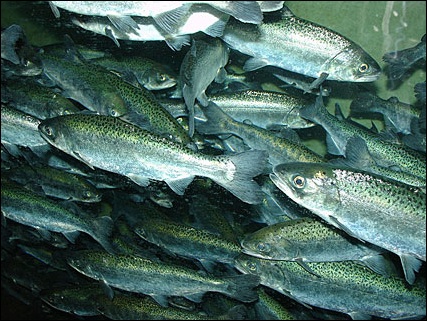
For more information see Russian River Instream Flow and Restoration Project (RRIFR)